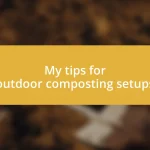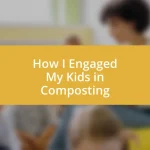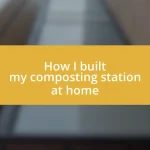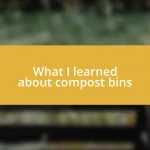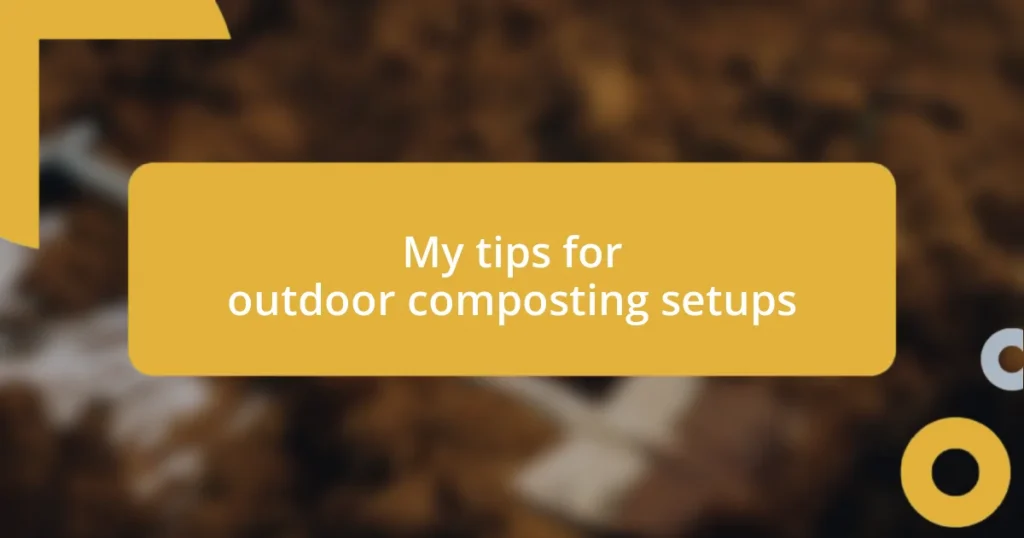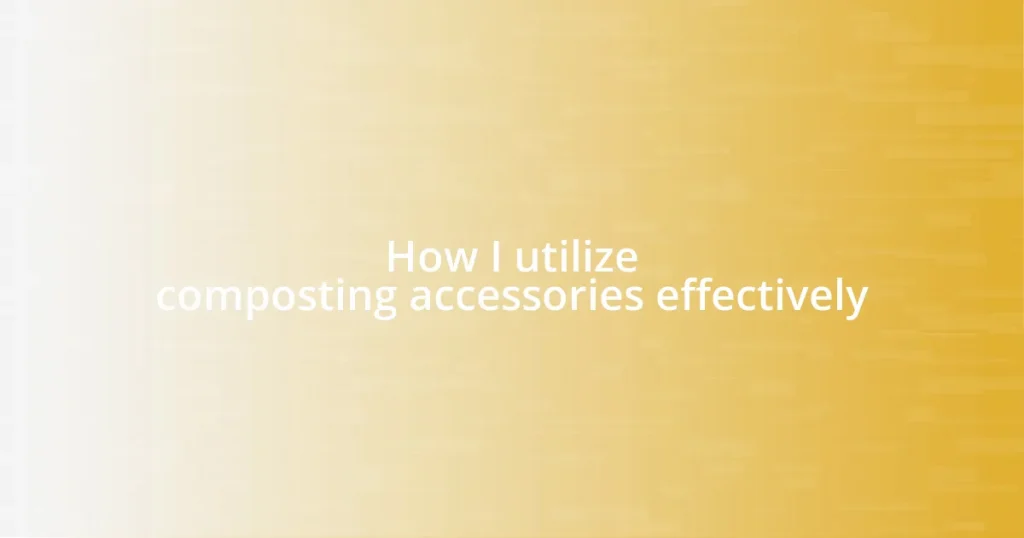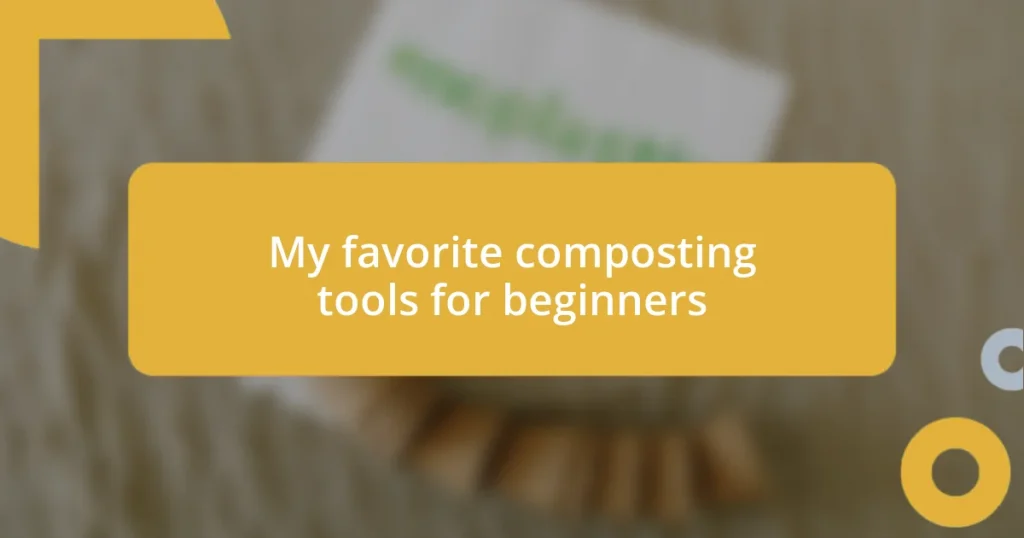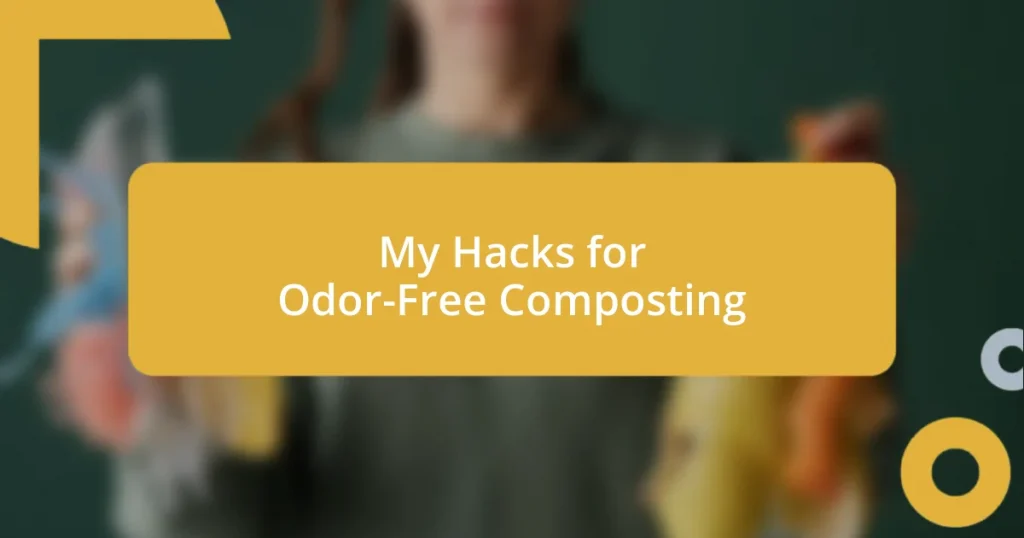Key takeaways:
- Successful composting requires a balance of green (nitrogen-rich) and brown (carbon-rich) materials, ideally in a 2:1 ratio.
- Choosing the right composting method and location enhances efficiency; consider factors like accessibility, sunlight, and drainage.
- Regular maintenance, including turning the pile and monitoring moisture and temperature, is crucial for effective decomposition and odor control.

Understanding outdoor composting basics
When I first ventured into outdoor composting, I was overwhelmed by the science behind it. But once I understood that composting is simply nature’s way of recycling, everything clicked into place. The process transforms kitchen scraps and yard waste into rich, dark soil, and I couldn’t help but feel a sense of accomplishment every time I added to my compost pile.
The key to successful composting lies in balancing green materials, like vegetable peels and grass clippings, with brown materials, such as dried leaves and cardboard. I remember the first time I realized how much kitchen waste could be diverted from the landfill. It was eye-opening, thinking about how something as simple as leftover apple cores could contribute to a healthier garden instead of sitting in a trash bin. Isn’t it amazing to think about the cycle of life we can foster right in our backyards?
Temperature also plays a critical role in the composting process. After a few weeks of turning my pile, I was shocked to feel the heat radiating from it—proof that decomposition was happening! It made me appreciate the microbial life working tirelessly inside. How often do we stop to think about what goes on behind the scenes? This dynamic ecosystem is not only fascinating but also essential for creating nutrient-dense compost.

Choosing the right composting method
Choosing the right composting method is crucial to ensuring a successful composting journey. I remember the excitement I felt when I began exploring different methods; some were sleek and sophisticated, while others seemed a bit rustic. Whether you opt for a compost bin, a pile, or even vermicomposting with worms, it’s essential to think about your available space, the materials you want to compost, and how much effort you’re willing to invest. Each method has its pros and cons, so taking the time to analyze what suits your lifestyle is vital.
In my experience, a composting bin tends to be more manageable, especially if you have limited space or want to keep things tidy. Plus, it often speeds up the composting process due to better airflow. However, I used to rely on a traditional compost pile, and I loved the rustic charm it added to my garden. It’s like a little patch of wilderness thriving right at home! But I had to keep an eye on the balance of materials and occasionally turn the pile, which could be quite a workout.
Vermicomposting also intrigued me, as it allows you to harness the power of worms to break down organic matter quickly. I can still vividly recall the first time I opened my worm bin; the sight of wriggly, happy worms effortlessly processing scraps was a unique thrill! This method can be particularly rewarding if you’re tight on space, as it can fit neatly indoors. Each method offers something special, and considering your goals will help you choose the one that fits seamlessly into your composting adventure.
| Composting Method | Pros | Cons |
|---|---|---|
| Compost Bin | Efficient, tidy, and suitable for small spaces | Cost may be higher, smaller capacity |
| Compost Pile | Larger capacity, easy to add materials | Less tidy, requires more management |
| Vermicomposting | Fast decomposition, great for indoor use | Requires maintenance; limited to certain materials |

Selecting an ideal composting location
Choosing the right spot for your compost bin or pile can greatly influence your composting success. I often reflect on my early days, when I learned the hard way that a poorly chosen location can lead to frustration. I remember placing my compost bin in a shaded corner of my yard, thinking it would be protected from the elements. However, it missed out on sunlight, which meant slower decomposition. I quickly realized that finding a well-drained area with a balance of sun and shade made all the difference.
When selecting an ideal composting location, consider these important factors:
- Accessibility: Ensure it’s easy to reach so you can readily add materials or turn the pile.
- Sunlight: A location that receives some sunlight can help accelerate the decomposition process.
- Drainage: Proper drainage is crucial; a spot that gets soggy can create odors and harm the composting process.
- Away from extremes: Avoid areas too close to your home or neighbors to minimize any unpleasant smells or pests.
- Proximity to materials: Placing your compost nearby where you often collect kitchen scraps or yard waste can make the process more convenient.
Reflecting on my own experience, I found that balancing these factors not only enhanced my compost’s efficiency but also made it a personal project I enjoyed visiting daily.

Building your compost bin structure
Building a sturdy compost bin structure is essential for creating an efficient composting system. I learned this firsthand when I decided to construct my first compost bin out of wooden pallets. It was an affordable solution, but I quickly realized that nails weren’t enough to hold it together during rainy days. Now, I recommend using screws instead; they provide better stability and ensure your bin can withstand the elements without falling apart.
Another important aspect is ventilation. I often emphasize the need for airflow because I’ve seen how it transforms the decomposition process. My first bin lacked proper ventilation, and I was eventually greeted with a foul smell that made me hesitate to turn the pile. By simply adding slats to the sides of my bin, I noticed a major improvement in both airflow and odor control. This small adjustment not only kept the compost healthy but also made me more excited to keep adding materials!
Lastly, don’t underestimate the importance of size when building your compost bin. When I initially started, I opted for a compact structure that could fit snugly in my yard. As my composting enthusiasm grew, I found myself wishing for more space to accommodate my ever-increasing scraps. I now suggest designing your bin with expansion in mind. Who knows? You may find yourself immersed in composting more than you ever imagined!

Balancing carbon and nitrogen materials
Balancing carbon and nitrogen materials is like creating a recipe for success in composting. In my experience, I’ve found that achieving the right mix can significantly speed up the decomposition process. For example, when I first started composting, I focused mainly on browns, like dried leaves and cardboard. I thought I was doing great until my compost pile became a dry, lifeless heap. It was a classic case of too much carbon without the balancing act of nitrogen-rich greens like kitchen scraps and grass clippings.
After realizing my mistake, I began to pay more attention to the proportions. Ideally, you want a rough ratio of about 2:1 carbon to nitrogen—two parts carbon-rich material to one part nitrogen-rich material. When I started mixing in more greens, such as vegetable peelings and coffee grounds, I witnessed a magical transformation. The heat generated in the pile was remarkable, and it turned into this rich, earthy compost that smelled incredible. It made me wonder how many others might struggle with this balance without realizing it!
I recommend keeping a “green” and “brown” bucket nearby while you collect your compost materials. This way, you can easily toss in the right balance as you work. Trust me; finding that harmony not only enhances results but also makes the composting journey feel like a fascinating experiment. What can be more rewarding than bringing your kitchen scraps back to life, turning them into black gold for your garden? Balancing carbon and nitrogen isn’t just a chore; it’s a pathway to enriching our environment and our lives.

Maintaining your compost pile
Maintaining a compost pile is all about the little details that make a big difference. One of my go-to methods is turning the pile regularly – it’s like giving it a gentle massage. I remember the first time I neglected that step; my compost sat stagnant, and honestly, it felt a little uninspired. After a few weeks without attention, I leaned in to turn it and was amazed by the transformation. The once dull heap sprang to life with rich, earthy smells and steam rising from the center. Trust me, turning your pile is a simple yet powerful way to rejuvenate it!
Another crucial aspect is keeping the moisture levels just right. Too dry, and the decomposition process stalls; too wet, and it can become a smelly mess. In my experience, I often gauge moisture by grabbing a handful of compost. If it feels like a damp sponge, you’re in the sweet spot. I vividly recall a rainy season when my compost pile turned into a soupy disaster. I learned the hard way that adequate drainage is key, so now I add a few twigs or straw at the base to help with airflow and moisture regulation. What strategies have you tried to maintain the right moisture balance?
Lastly, I can’t stress enough the importance of monitoring temperatures. The ideal range is about 130°F to 160°F (54°C to 71°C). The first time I used a compost thermometer, I felt like a proud scientist! I learned that when the temperature drops, it’s a clear sign that my pile needs a bit of attention—maybe by adding more greens or turning it out to fluff it up. This awareness not only makes the process more engaging but helps me ensure my compost develops into that dark, nutrient-rich gold every gardener dreams of. What are you waiting for? Dive into those thermostatic wonders and take your composting to another level!

Troubleshooting common composting issues
When troubleshooting common composting issues, one problem I often encountered was a smelly compost pile. Initially, I was perplexed by the foul odors wafting from my bin, which is a clear sign of anaerobic decomposition. After some introspection, I realized that my pile was too compact, preventing air from circulating. Ever since I started adding more dry browns and turning the pile more frequently, transparency and fresh earthiness have become the norm. Have you ever experienced that unpleasant aroma? It’s a wake-up call for adjustments!
Another challenge that might arise is the presence of pests or unwanted critters. I remember the first time I discovered little flies buzzing around my compost; it was like an unwelcome party crasher had shown up! I learned that this often indicates I’m tossing in more fruit scraps than my pile can handle. Now, I make a point to cover my food waste with a layer of browns, which not only hides the goodies but also absorbs excess moisture. Have you made changes to deter those pesky visitors? Simple tweaks can make a world of difference!
Lastly, sometimes the compost just isn’t breaking down as expected. I recall one winter when my pile froze solid, leaving me disheartened. It took a few attempts, but I eventually learned the importance of layering and insulation. I started adding leaves and straw not just for balance but as a protective layer. Keeping the pile warm and well-aerated has transformed it into a thriving environment for microorganisms. Have you had moments of frustration with slow decomposition? Remember, every setback is a lesson, guiding you to refine your composting skills!



